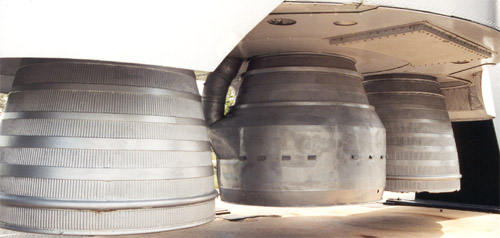
| Mercury Atlas |
This is a Mercury Atlas rocket (officially designated the Atlas LV-3 B). It is an Atlas D missile modified for Project Mercury launches. This one-of-a-kind example is located in the "Rocket Garden" at the Kennedy Space Center Visitor's Center.
The Atlas D was the first operational Atlas ICBM. Its first launch attempt (a failure) was on April 14th of 1959, at Complex 13. The first Mercury Atlas launch (MA-1, an unmanned mission) took place on July 29th of 1960 from Complex 14. It also failed, exploding nearly a minute into the flight. A total of nine Mercury Atlases (including four manned) were flown, of which two unmanned failed. The final flight of the Mercury Atlas was MA-9 (Faith 7, flown by Gordon Cooper).
The final Atlas D launch took place on November 7, 1967 from Vandenberg Air Force Base in California.
The first generation of
Atlas launch vehicles was manufactured by Convair Astronautics (General
Dynamics). The Atlas is still in service, with The Atlas II, Atlas III, and
Atlas V family of vehicles being manufactured by Lockheed Martin.
| Mercury Atlas specifications and performance | ||||||||||||||||||
| Length | 95 ft. | Diameter | 10 ft. | |||||||||||||||
|
||||||||||||||||||
